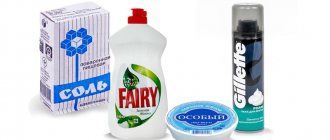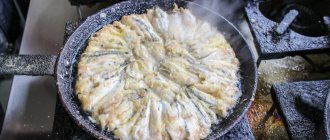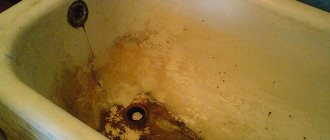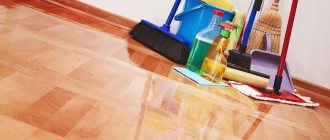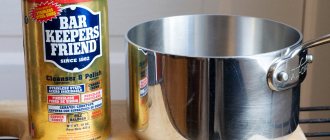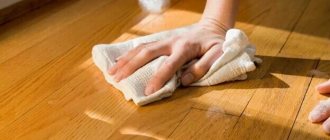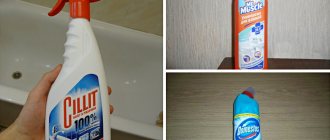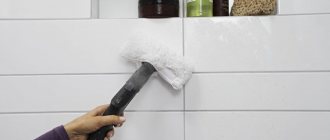Today, floor tiles are a popular coating that is valued by users for its practicality, high durability, and attractive appearance. Caring for it does not require much effort, which makes this material indispensable for finishing kitchens and bathrooms. But if you don’t take care of the tiled surface in a timely manner, then over time the dirt will penetrate deep into the tile and it will be difficult to remove it. In order to know exactly how to wash tiles on the floor, it is advisable to familiarize yourself with the most popular detergents, as well as traditional methods of cleaning such floor coverings. Subsequently, this will allow you to choose the most suitable option for yourself.
Cleaning a tiled floor does not require much time and effort, which is why this coating has become widespread Source sdelai-lestnicu.ru
Why do stains appear on the floor?
The main problem with tiled flooring is the appearance of foreign marks after cleaning. This happens for the following reasons:
- fat has not been previously removed from the surface;
- the base was washed with hard water;
- excessive use of detergent;
- the cloth used was poorly wrung out;
- The water was not changed during the cleaning process.
If you take into account the above-described nuances when carrying out the cleaning process, then there will most likely not be any stains left on the surface of the floor base.
Ceramic tile floors should be washed using glass cleaners and ammonia: they remove stains and add shine to the surface Source i.ytimg.com
Construction dust
The most harmless type of pollution, perhaps, is construction dust; its presence is inevitable when carrying out any repairs, both major and light cosmetic. After repairs, the tiles have to be washed to remove the accumulated layer of dust particles. At the same time, the question becomes relevant - how to wash the tiles and remove dirty stains without damaging its coating.
To begin with, it is recommended to sweep away the dirt with a dry cloth, and if possible, vacuum the surface. This will remove the main layer of dust and large particles that could damage the glaze. If possible, carefully scrape off any hardened finishing materials with a blade. Only after this will it be possible to begin wet cleaning to completely clean the tiled surface.
You can clean the tiles using the following means:
- Soapy water. The simplest, but very effective way. You can use washing powder.
- Water with lemon. Gives shine to a glossy surface and has a pleasant aroma.
- Vinegar. Also diluted in water. Suitable for cleaning serious stains, it also makes the surface shiny and creates a protective film.
- Glass cleaner. A simple, convenient and effective product that allows you to wash away dirt and remove stains from the surface.
Basic products for cleaning tiles from construction dust
How to wash properly
Cleaning a tiled floor properly is not difficult at all. In order for the tiles to simply shine clean later, it is enough to adhere to the following algorithm of actions:
- First of all, clean the surface using the dry method. This can be done using an ordinary broom or vacuum cleaner.
- Using highly effective detergents, perform wet cleaning.
- Add shine to the base.
Important! After completing each stage, you need to carefully inspect the floor in order to detect untreated areas in time. This will save you from having to redo the whole job all over again.
Ceramic tile floors should be washed using glass cleaners and ammonia: they remove stains and add shine to the surface Source i.ytimg.com
Pollution prevention
To some extent, avoiding the unpleasant consequences of repairs in the form of the need to clean the tiles from grout and tile adhesive residues on the floor of the bathroom or kitchen, from traces of primer, paint or whitewash when finishing walls and ceilings, will help with basic steps:
- When carrying out work involving the use of wallpaper paste, primers or various types of paints, the surface of the floor or walls lined with ceramic tiles must be covered with plastic film, paper, cardboard or any other suitable material available. Otherwise, stains from these substances can add a lot of work to your work during the final cleaning of the tiles.
- When installing porcelain tiles or tiles, any remaining adhesive mixture must be immediately removed from their surface with a damp rag or sponge. Cleaning dried adhesive, especially from embossed ceramic tiles, is a labor-intensive task and, in some cases, costly, requiring the use of expensive products.
- Difficult to remove stains can also remain from traces of grout that were not removed from the tile in time. That is, the remaining grout is removed as the work on processing the seams with a fugue is completed.
Use of special detergents
Often, floor tiles are washed using various special products. The choice of the latter should be taken responsibly. After all, most of them have a similar cleaning effect, but some nuances are observed. Before choosing the right composition for yourself, it is recommended that you familiarize yourself with the most popular products.
Silit
Designed for cleaning kitchens and bathrooms, it has excellent cleaning properties at an affordable price. This chemical composition helps to get rid of even old stains, destroys harmful bacteria, and perfectly disinfects the surface being treated.
Silit cleaning agent effectively copes with contaminants such as limescale, rust, soap stains and grease Source cdn.comfy.ua
Milit
A concentrated product created specifically for cleaning kitchens, produced in the form of a spray. It perfectly removes dirt on all types of kitchen surfaces. Additionally, economical consumption and affordable price allow you to significantly save your budget.
Sanitol
Convenient packaging and the presence of a spray bottle ensure economical application of the substance to the base. In this case, no time is required for preliminary preparation. In addition, it is worth noting that the composition does not have a strong odor. The only disadvantage of sanitol is its relatively high cost.
Sanitol has become widespread due to the absence of a strong odor and the presence of a convenient sprayer Source cdn1.ozone.ru
Selena
This product is used for complex cleaning. It allows you to completely rid the surface of greasy stains. To wash dirty tiles you need:
- Dilute the chemical composition in a small amount of water.
- Treat contaminated areas with the resulting liquid.
- Wait about five minutes.
- Remove greasy deposits with a rag.
Surface types
Before moving on to the description of cleaning methods, you need to understand the type of tile surface installed in your apartment. The effectiveness of using a particular cleaning product, as well as the necessary set of tools, depends on it.
Unpolished
A popular type of tile, increasingly used by residential owners to decorate bathrooms. Surface advantages:
- resists mechanical stress well;
- contaminants formed on its surface can be easily removed using detergents;
- acceptable price;
- does not slip underfoot.
Semi polished
Semi-polished tiles differ from other representatives in production technology. Its top layer is processed, like a polished one, but the removed layer is uneven over the entire area, which gives the product special characteristics.
The advantages of tiles include:
- greater strength than polished models;
- unique appearance;
- the products are wear-resistant;
- calmly tolerates significant temperature changes.
Polished
A facing material, during the creation of which special processing methods are used. Thanks to this, the product is endowed with the following characteristics:
- wear resistance;
- strength;
- uniformity;
- waterproof.
Cleaning such surfaces is not difficult, which cannot be said about other types of tiles.
Embossed
The peculiarity of relief tiles is that its surface consists of various patterns protruding beyond the boundaries of the general plane. It is often used in non-standard design solutions, having the following advantages:
- aesthetic appearance;
- wide range of patterns;
- coating strength.
See also
35 best products and instructions on how to care for leather shoes at home
There are only two disadvantages to such tiles:
- high price;
- difficulty of cleaning.
Glazed
Glazed tiles are covered with a transparent layer, giving the surface additional protection. It is easy to wash from various contaminants, and in terms of strength and moisture resistance, glazed tiles are in no way inferior to other competitors.
Matte
Matte cladding has a serious set of advantages, among which are:
- affordable price;
- pleasant appearance;
- high product strength indicators;
- a wide range of.
The main disadvantage of matte surfaces is their roughness. Because of this, a lot of bacteria accumulate on the surface, and the cleaning process is more difficult than usual.
Ceramic
Ceramic tiles, or tiles, are a facing material used to decorate bathrooms and toilets. It is made by pressing or extrusion, due to which the product is endowed with the following properties:
- strength;
- attractive appearance;
- resistance to external stimuli.
Liquid tile
Newfangled facing material filled with liquid gel. When pressure is applied to the tile, the gel changes location, which distorts the tile pattern. Thus, the appearance of the bathroom is constantly changing, surprising owners and guests with a variety of shapes and decorations.
Caring for such tiles is quite easy, but the price can seriously hit your wallet.
Traditional methods
If you are unable to purchase an expensive special cleanser or do not want to use toxic drugs, you can use home remedies. As a rule, they are less efficient, but at the same time they are environmentally friendly. In practice, such recipes are often used.
Vinegar
Regular acetic acid makes an excellent cleaning solution. Cooking method:
- Mix a liter of water with 90 ml of table vinegar.
- Pour the liquid into a spray bottle.
- Treat the stain.
- Rinse off the applied composition with clean water.
- Wipe the surface dry.
Attention! Vinegar essence cannot be used to make a cleanser (due to its high concentration). Food vinegar (9%) is most suitable.
https://m-strana.ru/articles/chem-otmyt-gruntovku-so-stekla/
Ammonia
Making a cleaning composition for floor tiles is very simple. To do this you will need:
- Prepare two liters of an aqueous solution of ammonia. The latter will only need one tablespoon.
- Pour liquid into the sprayer.
- Treat contaminated areas.
- Wait five minutes.
- Wipe the surface with a dry cloth.
Lemon acid
To clean tiles, you can use citric acid instead of vinegar. It needs to be diluted in warm water or poured onto a moistened sponge, then rubbed into the contaminated base.
Important! In addition to removing dirt from a tile floor, citric and acetic acids additionally disinfect it: they get rid of dangerous mold and other harmful organisms.
A solution of citric acid may cause skin irritation, so the day before using it, be sure to wear gloves. Source biotiki.org
putty
Often, after leveling floors and walls during repairs, traces of putty remain on the tiles. There are several ways to wipe them off:
- Soda solution. It is prepared like this: mix 20 grams of baking soda and 100 ml of water. Apply a cloth soaked in this liquid to the dirt for 15-20 minutes. After this time, the stains should be easily wiped off.
- Solvents (gasoline, acetone, kerosene). We also moisten a rag with the solution, apply it to the tile and then wash the surface.
A fresh putty stain can be easily washed off with hot water.
Video description
How to clean the grout between tiles quickly? Top 10 ways to clean tile joints.
Chalk
It is recommended to treat floor coverings made of glossy tiles with ordinary chalk. Procedure:
- Mix chalk and water to form a mushy consistency.
- Apply the prepared mixture to the surface of the tile.
- Remove the resulting layer along with the dirt.
Advice! To make the tiled floor shine, it additionally needs to be wiped with paper.
Chlorine
For those who can tolerate the unpleasant chlorine smell, it is recommended to try the following recipe:
- Dilute a tablespoon of chlorine in 1 liter of water.
- Treat the tiles with the prepared liquid. In this case, it is advisable to use a sprayer.
- Wait about ten minutes.
- Wipe the surface with a clean cloth.
As practice shows, a chlorine solution can easily cope with even stubborn stains. It is extremely important to use rubber gloves when cleaning.
All chlorine-containing compounds are toxic; if they come into contact with the skin or mucous membranes, the affected area should be rinsed thoroughly with running water. Source sib.fm
Grout
Another pressing question is how to clean the grout from the tiles after renovation. In general, this type of contamination is similar to an adhesive solution, but it will still be much easier to deal with.
The grout should be removed immediately after the top layer of material begins to lighten. This means that it has already set, but has not yet hardened completely.
In order to wash the tiles after grouting, immediately after completing the repair, moisten the tiles with clean water. This will soften the thin layer of mastic and allow it to be washed off like whitewash.
The tiles are washed off the grout with plain water immediately after repair, as soon as the top layer begins to lighten.
Please note: this method is only relevant for soft mixtures.
Epoxy grout is much more difficult to deal with. If a drop of the mixture gets on the floor on a tile, it is better not to torture yourself and the coating, but immediately buy a special epoxy solvent, without it it will be very difficult.
Video description
How to quickly clean grout lines in tile floors.
Melamine sponge
Excellent for removing dirt from glass, tiles, metal, and parquet. Before you start cleaning, you need to moisten it well, and then treat the contaminated area of the floor covering. It is especially effective to use melamine sponge in places where chemicals cannot be used and moisture is not allowed.
White melamine sponge is a licensed product made from special foam that does not contain chemicals or other cleaning and auxiliary substances Source 4.404content.com
Steam cleaner
A very simple, extremely easy to use household appliance. It is best suited for cleaning tiles in the bathroom and kitchen. Under the influence of the hot steam released by the device, the dirt instantly lags behind the base. At the same time, no traces remain on the surface at all. If you strictly adhere to the manufacturer's recommendations, there will most likely not be any major difficulties with cleaning.
Modern steam cleaners are made of stainless steel and therefore do not require the use of distilled water Source karex.ru
Primer
Now let's look at how you can clean ceramic tiles from primer after repair. White stains often remain on floor tiles, since the installation of wall cladding is carried out after it has been laid. It is advisable to spread a protective film on the floor, but this does not always provide a 100% guarantee of protection against stains.
If the primer gets on the tile, it is advisable to wash it off with clean water as quickly as possible. When the substance dries it will harden and it will be much more difficult to wash it off. For this purpose, you can use the following tools:
- special solvent-based remover;
- acetone;
- polyurethane foam;
- fresh primer.
As soon as the stain softens, you can try to clean it off. You can also use a special scraper with a sharp blade, which can be used to remove drops of frozen paint from glass surfaces.
The primer is best washed off before it hardens with clean water or solvent
How to wash flooring without streaks
To ensure that no traces are observed on the tiles after the cleaning process is completed, you must:
- First of all, clean the seams and joints in the corners of the room. Detergent is applied to the latter and left for three to five minutes. Then these areas are treated with a brush, and the remaining cleaning substances are removed with a rag.
- Wash the floor with a special product, after diluting it with water.
- To ensure that the tiles always remain in perfect condition, they should be washed regularly (several times a week).
To care for tiled floors, we recommend purchasing a special mop. Every stain that appears must be washed off in a timely manner. The latter will not allow dirt to penetrate inside the ceramic material and complicate future cleaning.
No. 12. Melamine sponge
A melamine sponge allows you to do without special cleaning agents ; more precisely, it is a detergent. Such sponges are made from melamine foam, which is capable of penetrating any hard surface and removing all kinds of dirt , stains and deposits. To clean, you only need to wet the sponge with plain water, using minimal effort. The melamine sponge can be used to clean a wide range of surfaces, incl. tiles.
How to clean tile floors from stubborn dirt
If you do not clean the tiles after each new stain, the dirt will dry out and then it will be difficult to remove.
A good remedy for getting rid of grease and rust is an aqueous solution of vinegar (1:1). When using a spray, it should be applied to a dirty surface, then wiped with a microfiber cloth.
Advice! When cleaning tiles, it is unacceptable to use used dish sponges: they can damage the floor base.
No. 6. Soda
Soda itself can also have a good effect on fatty stains . In general, this substance is considered a universal cleaning agent; it can also be used to remove, for example, coffee and tea stains that have become ingrained in dishes.
The washing method is the simplest: wet a sponge, dip it in soda powder and begin to carefully work the surface of the tile, dipping the sponge in soda powder again and again as necessary. Plaque and dirt should be cleaned thoroughly, but you should not press too hard to avoid scratching the tile. The method is effective even with serious contamination .
How to remove mold
In addition to limescale or dirt, the tiled floor often needs to be cleaned of mold that has formed in the area of the seams. In such a case, you need to prepare a cleaning composition from the following components:
- soda – 1/2 cup;
- vinegar - 1/4 cup;
- ammonia – 1/3 cup;
- water - 7 glasses.
The solution needs to be poured into a container with a spray bottle, then thoroughly treat the affected areas. After some time, the surface should be wiped with a pre-moistened cloth.
Additionally, a mixture of the above ingredients will disinfect the tile surface and get rid of bitumen stains and paint (water-based).
Blackening of the areas between the tiles over the entire surface of the floor or in certain places indicates that fungal bacteria are developing in the pores of the grout Source plitkahelp.com
Cleaning joints between tiles
The tile seams are the most vulnerable spot on a tiled wall. They quickly lose color because... Dirt most often accumulates in them and mold develops. They are also unstable to some cleaning agents. For example, under the influence of hard tools and acidic detergents, the grout mixture may collapse.
The following are considered safe for cleaning seams:
- Steam cleaner. A powerful jet of steam will not only clean any type of dirt, but also get rid of fungal infections. No additional chemicals are required.
- Toothbrush. It is convenient and safe to apply cleaning compounds.
- Gel and liquid bleaches and antiseptics.
If the seams cannot be cleaned or the area of clearance is large, then the easiest way is to replace the grout. To do this, you need to arm yourself with a thin, sharp tool (such as a scraper) to clean out the damaged grout, a new mixture (preferably epoxy) and a rubber spatula. During work, the seams must be soaked with an antiseptic.
Bleaching the seams
Seams that have darkened but remain intact and not affected by mold can be bleached. For work, use household chemicals or improvised products. The most common of them:
- Marker. It is simple to use, but the effect of such an update is short-lived.
- Ready-to-use composition with a whitening component - German Mellerud, Canadian Grout. Both products are designed for cleaning grout, have properties that restore the color of grout, and remove mold and stains.
- A mixture of hydrogen peroxide and baking soda. A paste of these ingredients is rubbed into the seams with a toothbrush and left for 1-2 hours. Then the seams are thoroughly wiped.
How to clean fat
Vinegar and baking soda will help thoroughly clean floor tiles from grease accumulations. If the latter are mixed and then applied to a heavily contaminated surface, then after a quarter of an hour all the dirt will dissolve. You just need to clean it with a damp cloth.
In addition, you can get rid of grease on tiles with the help of lemon. It easily removes stubborn stains from many food items. The dirt should be wiped with a lemon slice or treated with juice. Subsequently, even stubborn dirt will dissolve.
No. 11. Steam cleaner
If your apartment has a steam cleaner, it can also be used to clean ceramic tiles. Hot steam , escaping under high pressure, is capable of heating and dissolving contaminants . In this way, you can remove grease stains, plaque, deal with mold, neutralize spores and germs. After treatment, the surface of the tile must be cleaned with a damp sponge and then wiped dry with a soft cloth.
Rules of care
To avoid having to take drastic measures when cleaning tiled flooring, you must follow these useful recommendations:
- The joints must be treated with silicone sealant. This will prevent mold from forming between the tiles.
- Do not use abrasives to clean tiles. The latter can ruin the floor and deprive it of its beautiful shine.
- To disinfect tiles, it is recommended to use products containing bioenzymes.
- In order for the tiled surface to shine, it must be treated with a special product immediately after washing.
- Rough floors should be washed especially carefully: dirt often gets stuck in the cracks and serves as a breeding ground for germs.
Advice! Cleaning floor tiles cannot be put off for too long. Otherwise, contaminants will penetrate into the structure of the material, and it will not be easy to remove them later.
Cement
If the cement mortar has already dried, then it will not be easy to wipe it off; you cannot do it with improvised means. You can use toilet cleaner. The acids that make up it can cope with such contaminants. You can also purchase special formulations in the store.
In order to wipe off old cement you need:
- Wet a non-abrasive sponge with cleaning liquid;
- Apply it to cement for several days;
- Re-wet as it dries;
If it was not possible to avoid damage to the tiles, the defects can be hidden with additional decor or covered up, for example, with nail polish. It is best to use film or masking tape when carrying out dirty repair work to prevent such situations.
We wash linoleum after repair
Using the means listed above, linoleum can also be washed. It is better to exclude kerosene - not all types of coating can tolerate it. You cannot use gasoline or ammonia - not all types of linoleum are friendly with them either. These solvents, along with dirt, can also dissolve the protective coating, so we don’t take risks.
To clean linoleum after repair, you need a lot of rags
But you can add laundry soap and turpentine to the list. It is better not to use more aggressive means.
How to remove plaster, traces of whitewash
It is better to wipe off dried plaster stains as dry as possible. If there are tiles on the floor, just scrape it off with something, but try not to scratch it. For softer surfaces—linoleum—soak with acidified water (add vinegar) and scrub off little by little. If it is too difficult, any product with active acids will help to clean the floor. Among the most affordable are Toilet Duckling and similar products for the toilet or bathroom. But first read the composition - hydrochloric or any other acid should be indicated there. Just don’t try it on linoleum, parquet or laminate. Most likely, the coating will be damaged. If there is scrap material, test the product on it. After testing, is there any damage or discoloration? Try cleaning the plaster from the floor with this product.
How to wash linoleum after repair - with simple means: water + vinegar + dishwashing detergent
To clean the floor from putty or plaster, first try diluting a capful of the found acidic product in a small amount of water (a liter or one and a half). Apply the solution to the stain and wait a few minutes. Let's try to scrub it off. It helped - great. No, we're trying to increase concentration. Particularly persistent ones can be treated with an undiluted product. But if it doesn’t help, most likely you need to look for another remedy.
You can try softening plaster or putty stains with kerosene. Drop a couple of drops and wait, then try to wipe it off. But remember that it is better not to apply kerosene to laminate and linoleum.
When working with acids or kerosene, try to breathe “to the side.” Literally. The acid and kerosene evaporate and the vapor enters the lungs and can cause severe coughing. If you breathe long enough, it can even cause poisoning. In general, open the windows, ventilate and be careful. Whitewash, putty and other repair compounds are removed in the same way.
